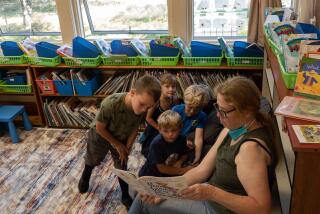N. Dakota School Feels Pinch of Tight Times as Drought Dries Up Funds
- Share via
PETTIBONE, N.D. — Pettibone has 150 people, three churches, two bars, a grocery store, a gas station, a post office, a grain elevator designed by a local eccentric to look like a prairie pagoda, and a school.
Pettibone School is by common consent the mainstay of this isolated, central North Dakota hamlet of wheat farmers and cattle ranchers. Few would dispute that it is what keeps Pettibone on the map.
But school officials--or more precisely, the school official, Howard Coughlin, who doubles as superintendent, principal, business teacher and driving instructor--say the drought and resulting hard times threaten the school’s, perhaps even the town’s, future.
Like the Farm Life
Many of the 65 students in kindergarten through 12th grade say they like the farm life and would stay here if only there were opportunities.
But there isn’t much for a young person besides school, an occasional movie in Jamestown 55 miles away, driving, drinking, reading, TV, the 4-H Club and church socials.
They do well in school. Michael Ziesch wasn’t satisfied with his excellent 28 of a possible 36,on the ACT college entrance exam he took as a junior and intends to top it this year. Carrie Mack runs the school newspaper and, like most students here, she plans to attend college.
But like most students, they plan to leave Pettibone.
“There’s nothing here unless you want to marry a farmer,” Mack told a visitor.
Isn’t Much to Hold Them
She might have added that there isn’t much to keep teachers, either--certainly not the salaries or social life.
Wanda Uhlich, who teaches world, American and North Dakota history for grades 7-12, said this year is her last in Pettibone. But she has fond memories of the day she arrived in town last year: “When I first came, and I was 23, people stopped me and said, ‘You must be the new schoolmarm.’ They actually used that word. They brought me vegetables from their garden. Everyone introduced themselves.”
Uhlich plans to go elsewhere next year. “There’s nothing to do at night. It’s a lot of work,” she said. “I don’t want to say it’s a dead end, but there’s no path for advancement. If I didn’t like my kids, I’d have burned out in the first year.”
Education at a school like Pettibone has its virtues: small classes, often with as few as half a dozen children. It’s just about impossible for a youngster to fall through the cracks.
Chemistry and physics are offered only in alternate years, but music lessons and a band survive. Even music is threatened by the drought, said teacher Jeanne Morrison. “I thought, boy, the drought is going to put the kibosh on fund-raising for music activities.”
No Librarian, Principal
The school’s virtues are outnumbered by its shortcomings. Pettibone has no industrial arts program, librarian or designated elementary school principal, and Coughlin lacks a master’s degree normally required of school superintendents.
Pettibone School offers one foreign language, German, but only once every four years, the minimum required by the state. If no Pettibone teacher is certified in language instruction that year, students must attend classes at another school.
The most pressing problems are too few children and too little money.
When one family left town because of the drought, Coughlin said, “that meant four fewer students, and that cost us $8,000 in state aid right there.” Along with other North Dakota schools, cuts in state school aid imposed by Gov. George Sinner in August because of the drought cost Pettibone $52 per student. Local land values have decreased 5% to 10% a year and property tax rates have had to be raised accordingly to maintain the school’s $230,000-a-year budget.
Talk is spreading about consolidating Pettibone with nearby schools in Woodworth and Robinson. Each resists the idea because they fear their towns would shrink further or even die without a school.
More to Read
Sign up for Essential California
The most important California stories and recommendations in your inbox every morning.
You may occasionally receive promotional content from the Los Angeles Times.













